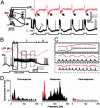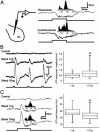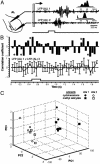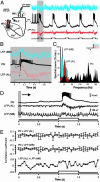Coordination of central odor representations through transient, non-oscillatory synchronization of glomerular output neurons
- PMID: 12960372
- PMCID: PMC196929
- DOI: 10.1073/pnas.1934001100
Coordination of central odor representations through transient, non-oscillatory synchronization of glomerular output neurons
Abstract
At the first stage of processing in the olfactory pathway, the patterns of glomerular activity evoked by different scents are both temporally and spatially dynamic. In the antennal lobe (AL) of some insects, coherent firing of AL projection neurons (PNs) can be phase-locked to network oscillations, and it has been proposed that oscillatory synchronization of PN activity may encode the chemical identity of the olfactory stimulus. It remains unclear, however, how the brain uses this time-constrained mechanism to encode chemical identity when the stimulus itself is unpredictably dynamic. In the olfactory pathway of the moth Manduca sexta,we find that different odorants evoke gamma-band oscillations in the AL and the mushroom body (a higher-order network that receives input from the AL), but oscillations within or between these two processing stages are not temporally coherent. Moreover, the timing of action potential firing in PNs is not phase-locked to oscillations in either the AL or mushroom body, and the correlation between PN synchrony and field oscillations remains low before, during, and after olfactory stimulation. These results demonstrate that olfactory circuits in the moth are specialized to preserve time-varying signals in the insect's olfactory space, and that stimulus dynamics rather than intrinsic oscillations modulate the uniquely coordinated pattern of PN synchronization evoked by each olfactory stimulus. We propose that non-oscillatory synchronization provides an adaptive mechanism by which PN ensembles can encode stimulus identity while concurrently monitoring the unpredictable dynamics in the olfactory signal that typically occur under natural stimulus conditions.
Figures





Similar articles
-
Temporal tuning of odor responses in pheromone-responsive projection neurons in the brain of the sphinx moth Manduca sexta.J Comp Neurol. 1999 Jun 21;409(1):1-12. J Comp Neurol. 1999. PMID: 10363707
-
Relationship between afferent and central temporal patterns in the locust olfactory system.J Neurosci. 1999 Jan 1;19(1):381-90. doi: 10.1523/JNEUROSCI.19-01-00381.1999. J Neurosci. 1999. PMID: 9870967 Free PMC article.
-
Multitasking in the olfactory system: context-dependent responses to odors reveal dual GABA-regulated coding mechanisms in single olfactory projection neurons.J Neurosci. 1998 Aug 1;18(15):5999-6008. doi: 10.1523/JNEUROSCI.18-15-05999.1998. J Neurosci. 1998. PMID: 9671685 Free PMC article.
-
GABAergic mechanisms that shape the temporal response to odors in moth olfactory projection neurons.Ann N Y Acad Sci. 1998 Nov 30;855:475-81. doi: 10.1111/j.1749-6632.1998.tb10608.x. Ann N Y Acad Sci. 1998. PMID: 9929641 Review.
-
Olfactory encoding within the insect antennal lobe: The emergence and role of higher order temporal correlations in the dynamics of antennal lobe spiking activity.J Theor Biol. 2021 Aug 7;522:110700. doi: 10.1016/j.jtbi.2021.110700. Epub 2021 Apr 2. J Theor Biol. 2021. PMID: 33819477 Review.
Cited by
-
Mixture and odorant processing in the olfactory systems of insects: a comparative perspective.J Comp Physiol A Neuroethol Sens Neural Behav Physiol. 2013 Nov;199(11):911-28. doi: 10.1007/s00359-013-0818-6. Epub 2013 May 10. J Comp Physiol A Neuroethol Sens Neural Behav Physiol. 2013. PMID: 23660810 Review.
-
Olfactory computations and network oscillation.J Neurosci. 2006 Feb 8;26(6):1663-8. doi: 10.1523/JNEUROSCI.3737-05b.2006. J Neurosci. 2006. PMID: 16467512 Free PMC article. No abstract available.
-
Spatio-temporal activity patterns of odor-induced synchronized potentials revealed by voltage-sensitive dye imaging and intracellular recording in the antennal lobe of the cockroach.Front Syst Neurosci. 2012 Jul 25;6:55. doi: 10.3389/fnsys.2012.00055. eCollection 2012. Front Syst Neurosci. 2012. PMID: 22848191 Free PMC article.
-
Space Takes Time: Concentration Dependent Output Codes from Primary Olfactory Networks Rapidly Provide Additional Information at Defined Discrimination Thresholds.Front Cell Neurosci. 2016 Jan 14;9:515. doi: 10.3389/fncel.2015.00515. eCollection 2015. Front Cell Neurosci. 2016. PMID: 26834563 Free PMC article.
-
Experimental and theoretical probe on mechano- and chemosensory integration in the insect antennal lobe.Front Physiol. 2022 Nov 2;13:1004124. doi: 10.3389/fphys.2022.1004124. eCollection 2022. Front Physiol. 2022. PMID: 36406994 Free PMC article.
References
-
- Gelperin, A. (1999) J. Exp. Biol. 202, 1855–1864. - PubMed
-
- Mori, K., Nagao, H. & Yoshihara, Y. (1999) Science 286, 711–715. - PubMed
-
- Laurent, G. (1999) Science 286, 723–728. - PubMed
-
- Christensen, T. A. & White, J. (2000) in The Neurobiology of Taste and Smell, eds. Finger, T. E., Silver, W. L. & Restrepo, D. (Wiley, New York), pp. 201–232.
Publication types
MeSH terms
Grants and funding
LinkOut - more resources
Full Text Sources

